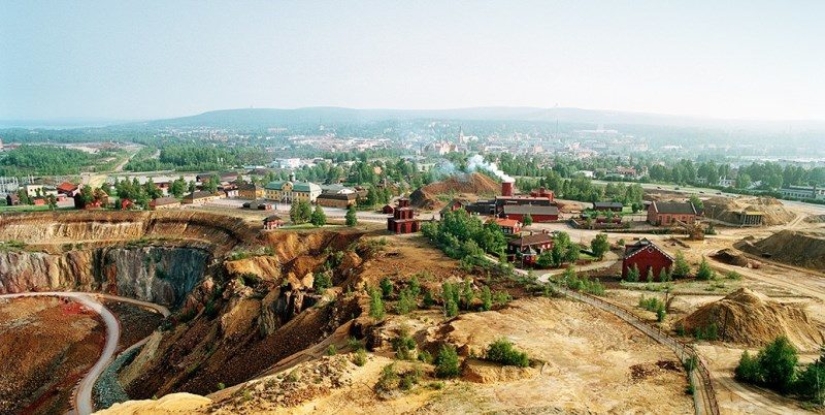How a miner turned into metal — the story of the "iron man" from Falun
By Pictolic https://pictolic.com/article/how-a-miner-turned-into-metal-the-story-of-the-iron-man-from-falun.htmlIn the summer of 1719, residents of the small mining town of Falun in central Sweden were excited by an extraordinary event. An "iron man" was found in an abandoned mine on the outskirts of the city. The event was clearly not accidental and promised diseases, crop failure and, possibly, the end of time and the coming of the Antichrist.

A huge crowd of local residents gathered near the mine where the frightening find was discovered. Everyone wanted to make sure that the young man lying on the grass in old-fashioned clothes was actually real. The young man did not pose any danger to others, as he had been dead for a very long time.

The surprise was caused by the way the deceased looked — it gave the impression that he was completely made of yellow metal, from the shoes on his feet and the coat, to the tips of his hair. After consulting with the people, the mayor of Falun decided to send the find to the local museum until the circumstances were clarified.
The "Iron Man" was carefully moved to the glass cabinet of the local exposition and made an important local landmark. People came hundreds of kilometers away to see the Falun metal guy, but even this did not shed light on his personality. The mystery was solved a few years later, when an elderly woman came to the city museum accompanied by her sons and grandchildren.

The lady immediately identified in the well-preserved body of her beloved, who went missing more than 40 years ago. The guy, whose name was Mats Israelsson, went to his beloved in the evening, but did not fall into the girl's arms. He simply disappeared, leaving no data about himself. Most likely, Mats was killed by robbers, and his body was thrown into the well of a copper mine abandoned many years ago.

After the name of the deceased was found out, the authorities decided to get rid of the body by attaching it to the ground. This decision was also facilitated by the fact that the "metal" corpse began to decompose, losing its attractive appearance for onlookers and poisoning everything around with miasma. In 1749, 30 years after the discovery of the body, it was finally given to the ground on the territory of the local church.

But the poor fellow Mats was not destined to find eternal rest — in 1860 the corpse was again removed from the grave and for a long 70 years was assigned to the already familiar Falun Museum. The progressive XX century finally helped Mats Israelsson to rest forever, at least I would like to hope so.

In the mid-1930s, the body was buried at the local cemetery according to all church rules and a tombstone with the name of the deceased was installed on the grave. To satisfy the curiosity of tourists, an exact copy of the "Falun man" was made of wax, which can now be seen in the museum of the city.

People from all over the world come to see the creepy exhibit and thanks to poor Mats, the provincial and not rich in sights mining town of Falun has become a popular tourist attraction. But what is the reason for the appearance of the "metal man"? What laws of physics and chemistry contributed to such an unusual mummification?

It turns out that there is nothing unusual in preserving the body of a Swedish guy. The reason for the appearance of an unusual body was a phenomenon well-known to science for more than 200 years, called "pseudomorphism". Complex chemical processes, which require special conditions, in some cases lead to the substitution of some substances by others.

It is very difficult to start such a process in artificially created conditions, but we know that nature is the best laboratory in which the most unusual exhibits can appear.
The body from Falun appeared due to the replacement of organic tissues with the mineral pyrite, which lies next to copper ores and looks like copper. The simplest example of pseudomorphism can be considered fossils preserved from prehistoric times.

There are also more illustrative examples, such as a malachite horse head from the Urals or an "iron" skeleton of a fossil seal from the Krivoy Rog mine in Ukraine.
The uniqueness of the "iron man", which is more correctly called "piritov", is denied by scientists. The only unusual thing about this phenomenon is that it happened to a person — the creepy and mystical halo of this case provided him with wide publicity, and the efforts of travel agencies contributed to the commercial use of an interesting archaeological site.
Recent articles

The late 1920s and early 1930s photographer Clifton R. Adams (Clifton R. Adams) spent in England, where he went on behalf of the ...

Why do we wear underwear? To take care of health, for hygienic purposes or playing along with fashion trends — one way or ...

Many nations have a tradition of stealing a bride. Nowadays, it is most often a symbolic ritual, the purpose of which is to ...